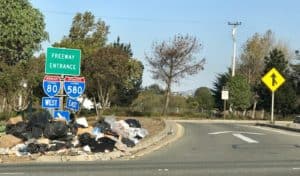
No matter where you live in the Bay Area, trash is one of our most persistent and visible pollution problems. It litters our roads and blights our cities, and much of the trash that you see on the street eventually washes down into storm drains and through a system of pipes that flow directly out to the Bay. In fact, this week’s rain is acting as the “first flush” of the season, when the first large storm flushes out all of the trash that has built up around the region into the Bay. A huge portion of this trash is the responsibility of a single state agency: Caltrans.
Caltrans owns and operates thousands of miles of highways and roads throughout the Bay Area, and is required by the State Water Board to keep roadway trash out of storm drains and waterways. Cities and counties in our region face similar requirements, and have been making substantial investments in trash screens and other pollution prevention solutions since 2010. Caltrans, meanwhile, has failed to comply with these regulations in the Bay Area since 2012. Trash from Caltrans roads often blows or flows onto city streets and becomes the responsibility of our local agencies, piling onto their already challenging trash issues.
In February the SF Bay Water Board finally took action: they issued Caltrans a cease-and-desist order that directs the agency to meet a series of trash reduction benchmarks and develop a legitimate plan for eliminating stormwater trash pollution from our state-owned highways and roads by 2030. Caltrans must begin by capturing trash from 2000 acres of roadways by June, 2020. Every two years after that, an additional 2000 acres of roadway trash must be captured.
Unlike the water that leaves your home through the sewer, which is treated to remove most contamination, storm water largely flows into the Bay unimpeded, carrying with it large amounts of trash pollution. Trash that ends up in the Bay can have a traumatic impact on Bay wildlife, degrades the beauty of this place that we all call home, and ultimately makes its way out into the Pacific Ocean where it contributes to the Pacific Garbage Patch and the alarming distribution of microplastics throughout our environment.
By failing to comply with its obligations, Caltrans is ensuring that our state-owned roads and highways continue to be a substantial source of this type of water pollution. Now that the Regional Board has acted, we must keep up the pressure to ensure that Caltrans follows through on its requirements. We cannot continue treating the Bay like a giant garbage can. It’s well past time for Caltrans to stop shrugging off its responsibility and do its part to make sure that our highways and state-owned roads don’t continue to be expressways for trash pollution.
Help amplify this message by joining our conversation on Twitter. Post your photo of trash on Caltrans highways and roads (any road with a number – like SR 123) and tag it #DontTrashTheBay and #CaltransFail.
























































